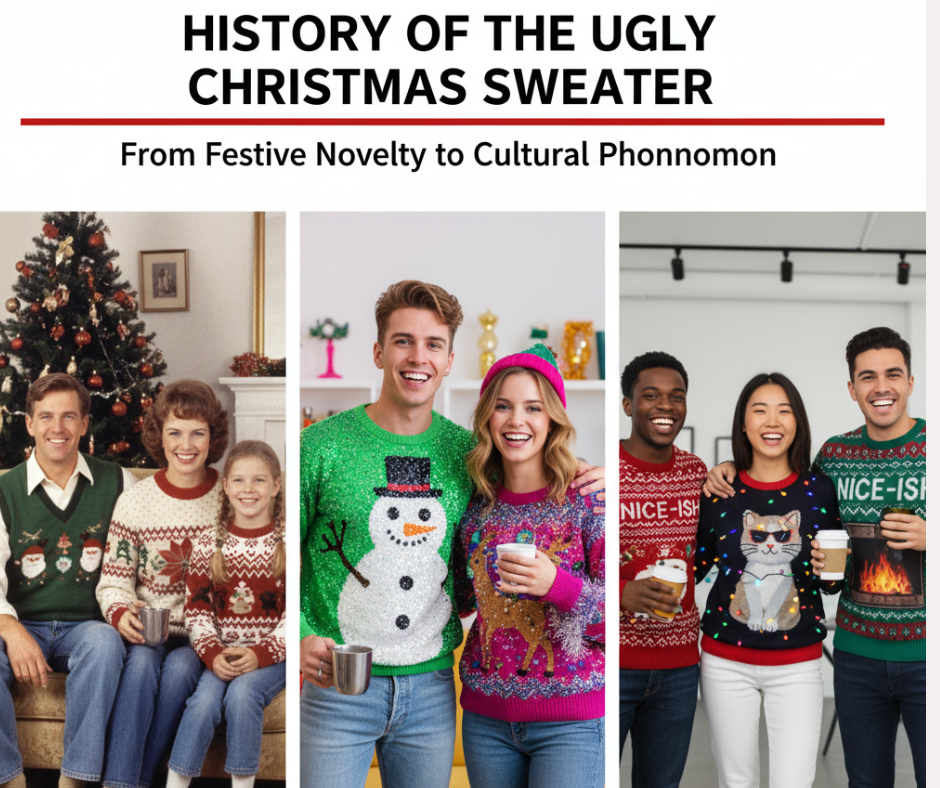The History of the Ugly Christmas Sweater has become an iconic symbol of holiday cheer, humor, and communal celebration. What started as simple festive knitwear has evolved into a cultural phenomenon, blending nostalgia, irony, and creativity. Each year, millions embrace the tradition of wearing these boldly decorated sweaters, often flaunting their tacky charm proudly at parties, family gatherings, and charity events.
This article explores the fascinating history of the ugly Christmas sweater, tracing its origins, cultural shifts, and how it became a staple of modern holiday festivities.
Early Origins: From Practicality to Festivity
The tradition of wearing festive sweaters during winter has roots extending back to the mid-20th century. In the early years, Christmas-themed sweaters were often handmade by relatives, featuring classic holiday motifs such as snowflakes, reindeer, and Christmas trees. They were worn more for warmth and seasonal spirit than fashion.
During the 1950s and 1960s, Christmas sweaters gained modest popularity as part of winter wardrobes, but they were generally simple and tasteful designs.
The Rise of “Tacky” Designs in the 1980s
The 1980s marked a turning point, as Christmas sweaters began to embrace bigger, bolder designs that were often described as “tacky” or “kitschy.” Bright colors, oversized motifs, and gaudy embellishments like sequins, pom-poms, and glitter transformed the humble garment into a playful statement.
These sweaters were sometimes gifts from well-meaning relatives or pieces purchased to evoke holiday humor. Though often unfashionable in broader society, they became playful symbols during the Christmas season.
The Role of Pop Culture
Media and movies played a crucial role in popularizing the ugly Christmas sweater trend. Films such as National Lampoon’s Christmas Vacation (1989) featured characters donning exuberant sweaters, cementing their association with holiday humor. Television specials, holiday advertisements, and celebrity sightings further propelled the trend into mainstream consciousness.
Social media’s rise in the 21st century accelerated the craze, enabling people worldwide to share photos, organize sweater parties, and launch campaigns promoting the sweaters’ playful spirit.
Ugly Sweater Parties: From Mockery to Celebration
Around the early 2000s, ugly Christmas sweater parties began popping up as themed gatherings celebrating the tackiest and most colorful holiday sweaters. These events encouraged creativity, humor, and a sense of community.
Participants compete for titles such as “Ugliest Sweater” or “Most Festive,” turning what was once considered a fashion faux pas into a desirable achievement. The party culture has grown into an annual tradition across workplaces, schools, and neighborhoods.
Commercial Boom and Market Growth
The demand for ugly Christmas sweaters has created a substantial commercial market. Retailers now offer extensive collections featuring everything from classic designs to pop-culture-inspired motifs and high-tech sweaters with flashing lights or sound effects.
Boutiques and online sellers cater to customers seeking unique, personalized sweaters, making the trend accessible globally. The market’s growth has also encouraged sustainable approaches like upcycling and ethical production.
Charitable Associations: Sweaters with a Cause
The ugly Christmas sweater tradition has also become a powerful tool for charity. Many organizations run “Wear Your Ugly Sweater” campaigns to raise money for various causes during the holiday season.
These charitable events combine festive fun with goodwill, encouraging donations and awareness, and reinforcing the sweaters’ place in community building.
The Fashion World’s Embrace
In recent years, the fashion industry has formally embraced ugly Christmas sweaters. Designers have released limited-edition collections blending holiday kitsch with high fashion, incorporating luxe materials, intricate craftsmanship, and modern aesthetics.
Runway shows, celebrity endorsements, and influencer promotions have elevated the sweater from a humorous novelty to a legit statement piece, bridging the gap between tradition and contemporary style.
How to Rock an Ugly Christmas Sweater Today
Wearing an ugly Christmas sweater is about fun and self-expression. Tips include:
-
Selecting bold colors and large, quirky motifs
-
Adding DIY touches like lights, ornaments, and patches
-
Coordinating with holiday themes or group costumes
-
Pairing the sweater with casual or festive accessories to maximize impact
The sweater should bring joy and laughter, embodying the holiday spirit with a playful edge.
High-Authority Source for History and Culture
For a comprehensive exploration of the ugly Christmas sweater’s origins and cultural significance, check out the University of Fashion’s detailed blog: University of Fashion – History of the Ugly Christmas Sweater.
Read More: Classic National Lampoon’s Christmas Vacation Scenes: Highlights of Holiday Humor and Heart
Conclusion
The History of the Ugly Christmas Sweater journey from simple winter wear to global cultural phenomenon is a story of humor, nostalgia, and community. Its evolution reflects changing attitudes towards fashion, tradition, and celebration, highlighting our collective love for festive fun.
Today, ugly Christmas sweaters symbolize more than kitsch—they celebrate creativity, togetherness, and the joy of embracing imperfections during the most wonderful time of the year.


Add a Comment